Top Rankings
Heber Springs School District ranks among the top 20% of public school district in Arkansas for:
Category
Attribute
Overall Rank
Highest overall rank (Top 10%)
Math Proficiency
Highest math proficiency (Top 20%)
Reading/Language Arts Proficiency
Highest reading/language arts proficiency (Top 10%)
Science Proficiency
Highest science proficiency (Top 20%)
Graduation Rate
Highest graduation rate (Top 20%)
For the 2025 school year, there are 3 public schools serving 1,558 students in Heber Springs School District. This district's average testing ranking is 10/10, which is in the top 10% of public schools in Arkansas.
Public Schools in Heber Springs School District have an average math proficiency score of 50% (versus the Arkansas public school average of 39%), and reading proficiency score of 51% (versus the 40% statewide average).
Minority enrollment is 10% of the student body (majority Hispanic), which is less than the Arkansas public school average of 42% (majority Black).
Overview
This School District
This State (AR)
# Schools
3 Schools
1,110 Schools
# Students
1,558 Students
485,111 Students
# Teachers
141 Teachers
38,779 Teachers
Student : Teacher Ratio
11:1
11:1
District Rank
Heber Springs School District, which is ranked within the top 10% of all 258 school districts in Arkansas (based off of combined math and reading proficiency testing data) for the 2021-2022 school year.
The school district's graduation rate of 90-94% has stayed relatively flat over five school years.
Overall District Rank
#23 out of 259 school districts
(Top 10%)
(Top 10%)
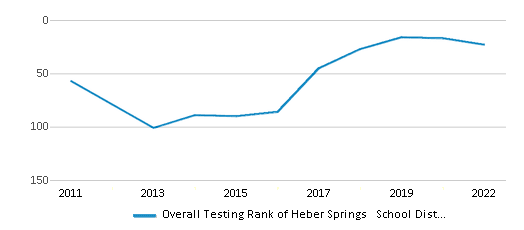
Math Test Scores (% Proficient)
50%
38%
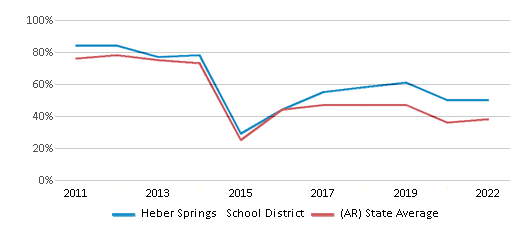
Reading/Language Arts Test Scores (% Proficient)
51%
40%
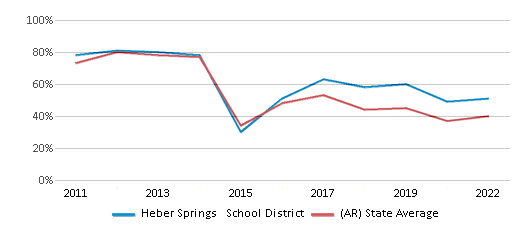
Science Test Scores (% Proficient)
44%
36%
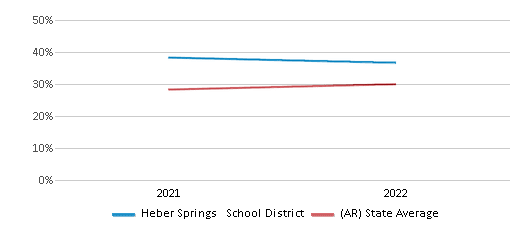
Graduation Rate
90-94%
88%

Students by Ethnicity:
Diversity Score
0.18
0.61
# American Indian Students
9 Students
2,795 Students
% American Indian Students
1%
n/a
# Asian Students
10 Students
8,854 Students
% Asian Students
1%
2%
# Hispanic Students
75 Students
71,016 Students
% Hispanic Students
5%
15%
# Black Students
4 Students
94,274 Students
% Black Students
n/a
19%
# White Students
1,408 Students
280,739 Students
% White Students
90%
58%
# Hawaiian Students
1 Student
4,966 Students
% Hawaiian Students
n/a
1%
# Two or more races Students
51 Students
22,677 Students
% of Two or more races Students
3%
5%
Students by Grade:
# Students in PK Grade:
-
10,102
# Students in K Grade:
110
34,850
# Students in 1st Grade:
119
35,859
# Students in 2nd Grade:
106
37,037
# Students in 3rd Grade:
126
35,957
# Students in 4th Grade:
103
35,919
# Students in 5th Grade:
125
35,951
# Students in 6th Grade:
112
36,175
# Students in 7th Grade:
143
36,641
# Students in 8th Grade:
136
37,270
# Students in 9th Grade:
118
39,879
# Students in 10th Grade:
131
39,369
# Students in 11th Grade:
122
37,430
# Students in 12th Grade:
107
32,498
# Ungraded Students:
-
174
District Revenue and Spending
The revenue/student of $11,913 in this school district is less than the state median of $13,132. The school district revenue/student has stayed relatively flat over four school years.
The school district's spending/student of $10,289 is less than the state median of $13,043. The school district spending/student has stayed relatively flat over four school years.
Total Revenue
$19 MM
$6,371 MM

Spending
$16 MM
$6,327 MM

Revenue / Student
$11,913
$13,132

Spending / Student
$10,289
$13,043
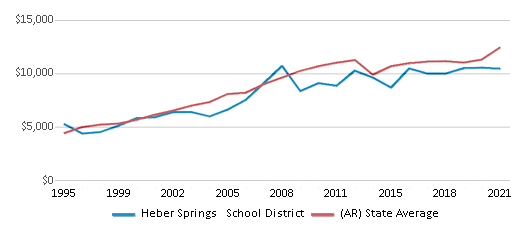
Best Heber Springs School District Public Schools (2025)
School
(Math and Reading Proficiency)
(Math and Reading Proficiency)
Location
Grades
Students
Rank: #11.
Heber Springs Middle School
(Math: 59% | Reading: 57%)
Rank:
Rank:
10/
Top 10%10
602 Case St
Heber Springs, AR 72543
(501) 362-2488
Heber Springs, AR 72543
(501) 362-2488
Grades: 6-8
| 391 students
Rank: #22.
Heber Springs Elem. School
(Math: 48% | Reading: 44%)
Rank:
Rank:
8/
Top 30%10
901 Front
Heber Springs, AR 72543
(501) 362-8155
Heber Springs, AR 72543
(501) 362-8155
Grades: K-5
| 689 students
Rank: #33.
Heber Springs High School
(Math: 37% | Reading: 52%)
Rank:
Rank:
7/
Top 50%10
900 W Pine St
Heber Springs, AR 72543
(501) 362-3141
Heber Springs, AR 72543
(501) 362-3141
Grades: 9-12
| 478 students
Frequently Asked Questions
How many schools belong to Heber Springs School District?
Heber Springs School District manages 3 public schools serving 1,558 students.
What is the rank of Heber Springs School District?
Heber Springs School District is ranked #24 out of 258 school districts in Arkansas (top 10%) based off of combined math and reading proficiency testing data for the 2021-2022 school year. This district ranks in the top 20% of Arkansas school districts for: Highest overall rank (Top 10%), Highest math proficiency (Top 20%), Highest reading/language arts proficiency (Top 10%), Highest science proficiency (Top 20%) and Highest graduation rate (Top 20%)
What is the racial composition of students in Heber Springs School District?
90% of Heber Springs School District students are White, 5% of students are Hispanic, 3% of students are Two or more races, 1% of students are American Indian, and 1% of students are Asian.
What is the student/teacher ratio of Heber Springs School District?
Heber Springs School District has a student/teacher ratio of 11:1, which is lower than the Arkansas state average of 13:1.
What is Heber Springs School District's spending/student ratio?
The school district's spending/student of $10,289 is less than the state median of $13,043. The school district spending/student has stayed relatively flat over four school years.
Recent Articles

Year-Round Or Traditional Schedule?
Which is more appropriate for your child? A year-round attendance schedule or traditional schedule? We look at the pros and cons.

Why You Should Encourage Your Child to Join a Sports Team
Participating in team sports has a great many benefits for children, there is no doubt. In this article you will learn what those benefits are.

White Students are Now the Minority in U.S. Public Schools
Increasing birth rates among immigrant families from Asia and Central and South America, combined with lower birth rates among white families, means that for the first time in history, public school students in the United States are majority-minority. This shift in demographics poses difficulties for schools as they work to accommodate children of varying language abilities and socio-economic backgrounds.





